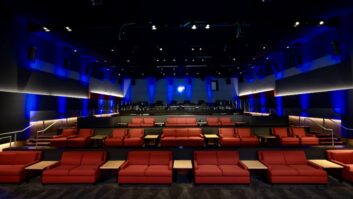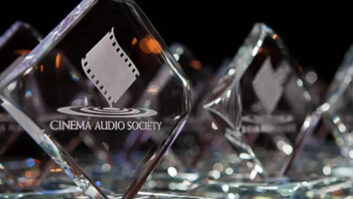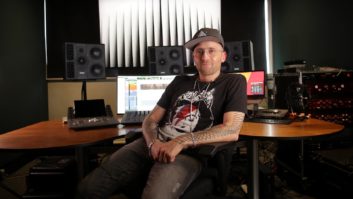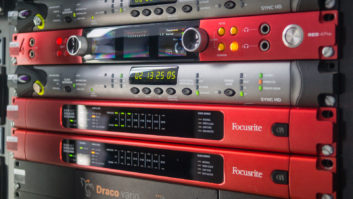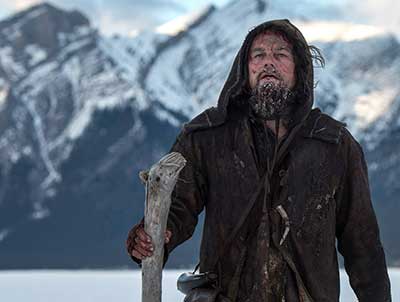
Hugh Glass is a revenant, a ghost, but he is no benevolent revenant. He is a revenant of revenge. In director Alejandro González Iñárritu’s film The Revenant, frontiersman Hugh Glass (played by Leonardo DiCaprio) seeks to avenge himself against the hunting party that left him for dead after a near-fatal bear attack. If revenge is best served cold, then it’s order-up for Glass, who survives and treks through the brutal northwest winter to track down his betrayers.
Set in the remote American wilderness of the 1800s, the harsh environment acts as another adversary in the film. The sound of wind is used to help the audience feel winter’s pervasive presence. Skywalker Sound’s Randy Thom, a supervising sound editor/sound designer/re-recording mixer on The Revenant, says director Iñárritu prefers rough-sounding wind full of rumbles and even distortion. “It’s that sound you hear when wind blows across your ears,” Thom says. “We used a lot of that in addition to every type of whistling wind and moaning wind you can think of.”
Custom-recordings of wind were captured at Point Reyes Peninsula near Skywalker Ranch in Marin County, Calif. “It’s always windy there, and there are many different surfaces for the wind to blow over, like trees, rocks, limbs, wires, and brush of all kinds,” he continues. “You can get wind with lots of different tonalities.”
Having tonal wind options was important as director Iñárritu often encouraged the post sound team to design elements that were musical. Additionally, the film’s composers—Ryuichi Sakamoto, Carsten Nicolai (aka Alva Noto) and Bryce Dessner used musical elements that could easily be mistaken for sound design.
“One of the interesting things about this film is that sometimes you can’t tell what is music and what is sound design,” notes Thom. “I love that, when you can’t necessarily tell which department a particular sound came from. As long as it does the storytelling that it needs to do, that is all that is really important.”

While The Revenant was still being shot, co-supervising sound editor/sound designer Martin Hernández started exploring music and sound options with director Iñárritu for several sequences. “We did these little sound exercises, what we called haikus—a small poem or short idea that makes sense on its own. These haikus used pieces of music I pulled from albums, and sound elements, and isolated lines of dialog here and there. I was making these haikus while thinking about the film; they weren’t done to picture,” Hernández explains.
Iñárritu and film editor Stephen Mirrione started cutting the sound haikus into scenes as they edited. After a few months, they found many of the haikus used music by Sakamoto. “It was a natural process to find out that he was the best candidate to be the composer for the film because we were already tied to his influence and his music,” says Hernández. “Ryuichi [Sakamoto] heard all the sound exercises we did before he started composing for the film, along with Carsten Nicolai. These haikus influenced the score later on.” According to Hernández, two of those early haikus, which play in crucial scenes near the end of the film, made it to the final mix exactly as he built them. “That tells you how much the music ideas can stick and be a part of the scene for Alejandro [Iñárritu]. He heard the scenes with that music and it stayed there until the very end.”
Cutting music in conjunction with sound design is an approach that started for Hernández and Iñárritu last year on Birdman, where Hernández built tracks by cutting takes of Antonio Sanchez playing the drums. “We discovered that a good amount of sound design can come just by cutting the music, and treating and changing the music to fit a scene,” says Hernández. “Alejandro is driven by pieces of sound, and pieces of dialog, and pieces of music. The storytelling aspects of sound are very strong for him. Everything that happens in sound has a natural correlation with the image, but it’s not isolated. In many ways, it is one and the same thing,”
Iñárritu put tremendous effort into visually presenting a cold, raw reality in The Revenant by shooting outdoors in harsh conditions and only using natural light. That passion for realism carried over to the sound. He sought out Thom, who specializes in creature vocals, to craft a realistic bear attack that comes from an entirely CG bear. “There was never any real bear that was being photographed. ILM (Industrial Light & Magic) did a wonderful job on the visuals, making the bear believable visually. It looked dirty, and leaf covered and grimy, as a bear would be roaming around in a wet forest,” says Thom. “The challenge for us was to do something on the same level with sound. It had to be all organic, and we had to be careful the bear attack didn’t sound ‘Hollywood,’ not overdone and exaggerated.”
The bear displays a range of emotion, from being nurturing with her cubs, to being aggressive during the attack, and afterwards, being injured. Starting with Skywalker’s extensive sound library, Thom pulled a variety of bear vocalizations. For the injured bear sounds, Thom built its heavy breathing using recordings of horses with respiratory problems. And since the library didn’t have recordings of a bear attack, Thom admits, “I had to resort to using my own voice a couple of times, too. Luckily I’m a big guy with a big voice and so I can pass as a 400-pound bear if necessary.” He used Serato’s Pitch ‘n Time Pro to help make the separate elements sound as if they’re coming from the same animal. “Creature vocalizations are the hardest kind of sound design to do, and the bear attack sequence is fairly long. I had to make it dynamic, and run the gamut of emotions the bear goes through.”

The Revenant was mixed in 7.1 on a Harrison MPC4-D console in the Hitchcock Theatre at Universal Studios in Universal City, Calif., by re-recording mixers Frank A. Montaño and Jon Taylor. Additional sound effects mixing was handled by Thom and Montaño on Universal’s Stage 6. After the final 7.1 mix was crafted, a Dolby Atmos mix was built based on the 7.1 mix automation, as well as a 12-channel and a 5.0 IMAX mix. Montaño, who mixed Iñárritu’s Birdman with Taylor last year, notes The Revenant’s soundtrack is a delicate blend of dialog, music, and nature that all move in a non-traditional way.
“The camera is always moving to some degree, and sound follows,” Montano says. “Our goal was to always have enough movement without being distracting and having the audience lose focus on the story. Alejandro is always exploring how picture and sound feel together; it may be a literal-sounding scene or a subjective-sounding scene that has the correct impact to create the right feeling for that moment, and that’s when he says, ‘We got it.’”
Taylor, who handled the dialog, ADR, walla and music, says the challenge on his side of the board was incorporating the countless lines of ADR into the production dialog. According to Taylor, director Iñárritu wanted to be extremely accurate with the different Native American languages, which actually change from the past and present in the film. “This meant lots of ADR throughout the mix,” says Taylor. “Nothing about this film is standard and no single sound just went by. Every possibility was explored.”
“Alejandro is making a very different film,” Hernandez concludes. “It’s very different from Birdman, and it’s very different from his other films. So for him it is a discovery process and it’s an ongoing process that’s still changing. Being a part of that discovery process is very satisfying, but it can be very challenging. When something you did feels like it belongs and really helps to tell the story that Alejandro wanted, that is very satisfying. It really pays off for all the hours you put in.”
